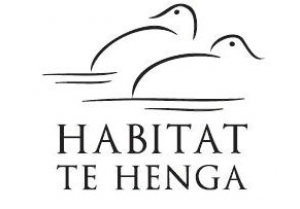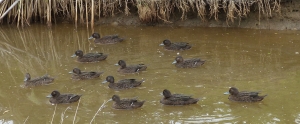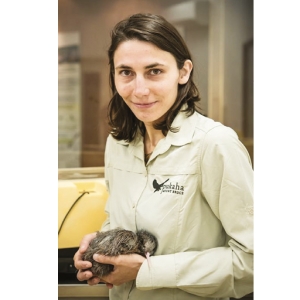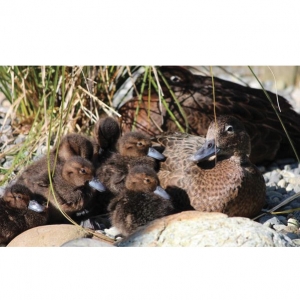Displaying items by tag: Pateke
Brown teal/Pateke
The Isaac Conservation and Wildlife Trust
Brown teal/Pateke
The Isaac Conservation and Wildlife Trust’s seven brown teal/pateke breeding pairs laid their first clutches, with 34 ducklings hatched in total.
Laying of second clutches has now begun. Two older pairs have been released on Rotoroa Island in the Hauraki Gulf, making way for a clutch of orphans coming off Great Barrier Island – providing new genes for the captive breeding programme. The Trust continues to be the major breeder in producing the largest brown teal output for release into the wild.
Find out more about the Trust’s captive breeding activities on Facebook
Breeding success continues at Mt Bruce Pukaha
Breeding success continues at Mt Bruce Pukaha
Shore Plover:
26 chicks were raised with some released at Waikawa and some at Motutapu. Four remain at Pukaha to continue with the breeding programme.
Pateke:
18 ducklings from the two breeding pairs at Pukaha. These were sent to the pre-release site, Peacock Springs near Christchurch, before they are released into the wild.
Whio:
2 male and 1 female ducklings hatched and reared by a pair at Pukaha have been sent to the pre-release site at Turangi. 13 ducklings were hatched from eggs collected from wild sites and of these 9 are male and 4 are females. They will remain at Mt Bruce Pukaha.
Habitat Te Henga
As the end of the year approached, the Pateke at te Henga were still holding their own and week after week 17 birds were being detected, that is an 85 percent survival. Accordingly, the Pateke Recovery Group indicated that all would be on for a February release and could we please ensure that transmitters and harnesses were arranged and sent to Peacock Springs in readiness?
Again, as last year we would require 20 transmitters and harnesses while this year we would also have additional birds without transmitters and the success of this year would again be judged on the fate of the transmitter carrying birds. Expecting perhaps a total of 40 or 50 birds we were stunned to be told to expect 80!
Last year’s release took place on our Forest and Bird Matuku reserve and allowed only a brief glimpse of the Pateke as they rapidly scrambled across a couple of metres of water into dense reed beds rarely to be seen again.
Wanting a better spectacle this year and ensuring that the ducks would be released into the centre of our predator controlled area, the decision was made to renovate an old boardwalk that projected into a large pond so that most of the birds would be released here with a small number at a site offering easy access from a private property nearby.
Many days of activity followed with a couple of us clearing the old boardwalk and constructing a large deck at its far end. Pointed poles 3.6m in length were manhandled, forced through the weed mass then rammed into the muddy substrate below. Bearers, then joists were attached -often a tricky job as being without electricity, a brace and bit at or just below water level was needed. Of course, with the sea only one or two km away, all fittings had to be stainless steel to withstand possible wind driven salt exposure.
With four days to spare the deck was ready along with some under water weeding of the Eleocharis reeds done from kayaks.
Air New Zealand delivered even ahead of their ETA so we had a good start back from Mangere airport to te Henga. A large crowd was waiting and our PR representative had really done her job well with TV and newspapers both national and local all present. Volunteers helped move the boxed ducks across the river on the raft then walked them 500m to the deck where 60 birds were let go, five at a time.
Then it was all back to the more public site where after karakia and speeches, several people, old and young, had the opportunity to release a duck. My speech included a call to pass the hat around, as at this stage we still hadn’t obtained funding for the monitoring required of us- the handful of dollars received wasn’t going far but fortunately Auckland Council Biodiversity had decided to fund this aspect.
And what has happened since?
Big numbers certainly have made the difference in the number of sightings with groups of 8 or 9 having been seen. Again as last year, one or two birds absconded early on. Pateke Point we call it, is a site where pateke routinely seem to enjoy fluffing around protected by the overhanging willow canopy. What a dilemma, as I have been hell bent on getting rid of all the willows in our reserve. Perhaps we’ll leave just these few until replacement planting is mature enough. A transmitter carrying bird has perished cause unknown, while a non-transmitter carrying bird was killed by a car but apart from 3 or 4 adventurous birds, most seem to be sticking close to the release site.
Working back from the deck is a wide elevated boardwalk finished thanks to materials and some labour supplied by Henderson Rotary. A seat and information panel midway will give an opportunity to read about the serial vegetation starting from the cabbage trees, then flax then raupo and other increasingly water requiring sedges, and swamp millet etc.
Hopefully before winter arrives we will have had some nights monitoring where the Pateke forage. With a borrowed radio receiver we’ll have two teams attempting to get fixes from two different sites and follow a small number of Pateke at regular intervals for a few hours. An opportunity also to access some night vision glasses may give some insight as to the ducks movement or if nothing else will give the local mosquitoes a picnic. Then there is the planned pest monitoring using chew cards attached to stakes placed through parts of the swamp. Seems like an interesting project in theory but as always there’s plenty to do at te Henga.
John Sumich
Pateke counts
A little old but of interest to those who care about Pateke.
We will obviously have to extend our daytime surveys further up into the forest in future.
I have seen Pateke way up on the open hills in pitch darkness probably 1km from their daytime roosts showing just how nocturnal they are. And Surprise, surprise WAY up stream on ecology track.
Roger and Patte Williams
Tawharanui Pateke Counts from Sharon Kast is a good record to have. This is consistent with the work of Katie Sheridan at Zealandia, her presentation to Sanctuaries of NZ hui last was of interest. Unfortunately no notes with her slides but I do remember the story was these birds go well up some of the waterways (consistent with sub fossil records that had pateke as one of our more common riverine forest bird species before mammalian depredation).
Also- ‘flock counts’ under represented the population by as much as 50 percent (proportion of known birds present at flock site at any one time, most go there eventually) and some birds with stable territories never left their home territory to visit flock sites.
Matt Maitland
For those interested in Pateke, here is a link to some interesting information and photos.
MB100 – a milestone for Pukaha
MB100 – a milestone for Pukaha
Pukaha was delighted to announce the 100th kiwi chick to be hatched in the nursery since it started hatching kiwi chicks under human care in September 2005 MB100 made its way into the world on March 18, 2017. Lead kiwi ranger, Jess Flamy, was on hand to assist. Jess has supervised the hatch of nine kiwi at Pukaha this year so MB100 was in very safe hands!
To celebrate the 100 milestone hatch, Pukaha held a Kids Go Free day in March when MB100 was having one of its first feeds at 12 noon.
Pateke – clutch No. 3
More conservation breeding success with the hatch of five more pateke ducklings in the Free Flight Aviary. This is the third clutch for the same pateke pair this year so they must be pretty happy in their new home. Mum is fairly happy showing off her new brood and at 4pm daily there is a ranger talk in the Free Flight Aviary and the pateke are usually happy to eat the mealworm treats they get at that time on their pond.
DOC does its bit
Kea set free after successful leg surgery
A young kea has been released back into the wild in Fiordland after his severely injured leg was successfully remodelled by vets. Thanks to Real Journeys, Air New Zealand and Meridian Energy for being involved in this happy ending.
Rare native buttercup found on Stewart Island
The mount Allen buttercup was found by DOC botanists on a remote mountain range on Stewart Island/Rakiura. The island is a hotspot for endemic plants with at least 28 native plants, many of them alpine species, found there.
Motley Crew arrive in Hawke’s Bay
Kōrure (mottled petrels) have been translocated from Whenua Hou (Codfish Island) to their new home at Maungaharuru. These translocations gave 67 birds a new home and are part of an effort to restore seabird populations.
New hatchings at Pukaha Mount Bruce
September 2017: Pukaha Mt Bruce
Since staff at Pukaha last caught up, the Pateke pair now have six ducklings in their care. The Whio, that live in their free flight aviary have also been sitting on a clutch of five eggs.
Also the first monitored wild kiwi chicks were safely hatched in the reserve. Staff said it was great to see the first conservation breeding of the season had taken place in the new free flight aviary. It is a super sign that the wildlife love this new space as much as the visitors who go to see the new young ones at Pukaha.
Free flight aviary popular at Pukaha Mt Bruce
At Pukaha Mt Bruce staff have been delighted with the way the birds have settled into their new home in the free flight aviary. The whio and pateke are loving their new areas and are not difficult
to spot. The whio are in an ‘internal aviary’ with a new river run while the other birds are all together in the bigger aviary space. Both the pateke and whio are breeding pairs.
The korimako seem to spend all day singing and while the kaka and kereru took a little while to settle in, they are now happy and busy in their new space and are almost oblivious to the visitors
who walk through the aviary.
If you are lucky enough to be at Pukaha at the free flight aviary at around 4pm there could be a ranger talk at the “Final Flight” area. It tells the story of the restoration project for the Pukaha forest and how captive breeding can help to protect and grow our endangered species.




